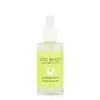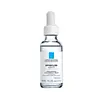What's inside
What's inside
 Key Ingredients
Key Ingredients

 Benefits
Benefits

 Concerns
Concerns

 Ingredients Side-by-side
Ingredients Side-by-side

Vitis Vinifera Juice
AntioxidantCitrus Aurantium Dulcis Juice
Skin ConditioningAloe Barbadensis Leaf Juice
Skin ConditioningGlycerin
HumectantTriethyl Citrate
MaskingGluconolactone
Skin ConditioningOenothera Biennis Oil
EmollientLinum Usitatissimum Seed Oil
PerfumingBorago Officinalis Seed Oil
EmollientVitis Vinifera Seed Oil
EmollientHelianthus Annuus Seed Oil
EmollientPullulan
Sodium Benzoate
MaskingLaminaria Ochroleuca Extract
Skin ConditioningUbiquinone
AntioxidantDimethylaminoethanol Tartrate
EmollientThioctic Acid
AntioxidantMagnesium Ascorbyl Phosphate
AntioxidantTocopherol
AntioxidantSodium Hyaluronate
HumectantSclerotium Gum
Emulsion StabilisingXanthan Gum
EmulsifyingSodium Stearoyl Glutamate
CleansingSodium Gluconate
Skin ConditioningCaprylic/Capric Triglyceride
MaskingAlcohol Denat.
AntimicrobialGluconic Acid
Sodium Hydroxide
BufferingCitrus Aurantium Bergamia Fruit Oil
MaskingCitrus Aurantium Dulcis Peel Oil
MaskingVitis Vinifera Juice, Citrus Aurantium Dulcis Juice, Aloe Barbadensis Leaf Juice, Glycerin, Triethyl Citrate, Gluconolactone, Oenothera Biennis Oil, Linum Usitatissimum Seed Oil, Borago Officinalis Seed Oil, Vitis Vinifera Seed Oil, Helianthus Annuus Seed Oil, Pullulan, Sodium Benzoate, Laminaria Ochroleuca Extract, Ubiquinone, Dimethylaminoethanol Tartrate, Thioctic Acid, Magnesium Ascorbyl Phosphate, Tocopherol, Sodium Hyaluronate, Sclerotium Gum, Xanthan Gum, Sodium Stearoyl Glutamate, Sodium Gluconate, Caprylic/Capric Triglyceride, Alcohol Denat., Gluconic Acid, Sodium Hydroxide, Citrus Aurantium Bergamia Fruit Oil, Citrus Aurantium Dulcis Peel Oil
Water
Skin ConditioningAlcohol Denat.
AntimicrobialHydroxyethylpiperazine Ethane Sulfonic Acid
BufferingGlycolic Acid
BufferingDiisopropyl Adipate
EmollientPropylene Glycol
HumectantPentylene Glycol
Skin ConditioningCitric Acid
BufferingPPG-26-Buteth-26
Skin ConditioningPEG-30 Glyceryl Cocoate
EmulsifyingPEG-40 Hydrogenated Castor Oil
EmulsifyingSodium Hydroxide
BufferingP-Anisic Acid
MaskingHydrolyzed Hyaluronic Acid
HumectantCapryloyl Salicylic Acid
ExfoliatingTetrasodium EDTA
Polyquaternium-10
Water, Alcohol Denat., Hydroxyethylpiperazine Ethane Sulfonic Acid, Glycolic Acid, Diisopropyl Adipate, Propylene Glycol, Pentylene Glycol, Citric Acid, PPG-26-Buteth-26, PEG-30 Glyceryl Cocoate, PEG-40 Hydrogenated Castor Oil, Sodium Hydroxide, P-Anisic Acid, Hydrolyzed Hyaluronic Acid, Capryloyl Salicylic Acid, Tetrasodium EDTA, Polyquaternium-10
Ingredients Explained
These ingredients are found in both products.
Ingredients higher up in an ingredient list are typically present in a larger amount.
Alcohol Denat. is an alcohol with a denaturant property. It is created by mixing ethanol with other additives.
This ingredient gets a bad rep because it is irritating and drying - mostly due to its astringent property. Astringents draw out natural oils in tissue, constricting pores and leaving your skin dried out.
However, alcohol denat. is not all that bad.
Due to its low molecular weight, alcohol denat. tends to evaporate quickly. One study on pig skin found half of applied alcohol evaporated in 10 seconds and less than 3% stayed on skin.
This also helps other ingredients become better absorbed upon application.
Studies are conflicted about whether this ingredient causes skin dehydration. One study from 2005 found adding emollients to propanol-based sanitizer decreased skin dryness and irritation. Another study found irritation only occurs if your skin is already damaged.
Small amounts of alcohol are generally tolerated by oily skin or people who live in humid environments.
The rule of thumb is if this alcohol is near the end of an ingredients list, it will probably not affect your skin much.
Also...
This ingredient has antimicrobial and solvent properties.
The antimicrobial property helps preserve products and increase their shelf life. As a solvent, it helps dissolve other ingredients.
Other types of astringent alcohols include:
Learn more about Alcohol Denat.Sodium Hydroxide is also known as lye or caustic soda. It is used to adjust the pH of products; many ingredients require a specific pH to be effective.
In small amounts, sodium hydroxide is considered safe to use. However, large amounts may cause chemical burns due to its high alkaline.
Your skin has a natural pH and acid mantle. This acid mantle helps prevent harmful bacteria from breaking through. The acid mantle also helps keep your skin hydrated.
"Alkaline" refers to a high pH level. A low pH level would be considered acidic.
Learn more about Sodium Hydroxide